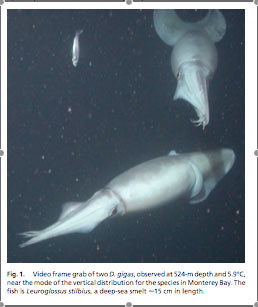A Dark (but Goofy) Mascot
Environmental Trends Portend a New Totem for Pacific NW: the Giant Squid
7/5/08, Charleston, OR--With eyes the color of steel, grey hair and a creased, weathered face, Paul Merz looks like an ancient mariner.
|
Taking a drag from his cigarette, he shifts his plastic chair to get a better view of his troll boat, the MV Joanne. In 2003, in a span of three hours, Merz landed eighty Chinook salmon, each weighing five to ten pounds, on the Joanne. The catch was glorious for its time. With the price of salmon at $13 a pound this year, that three hour catch could have netted Merz ten thousand dollars! He had bought the boat just the year before, with thirty years’ worth of savings. The year after his epic catch, ESA regulations closed marine fisheries near the mouth of the Klamath to protect the river’s dwindling Coho salmon stock.
Today, Merz and Joanne sit grounded outside his wife’s garden ornament store, surrounded by angel and pelican whirligigs, waiting out their fourth fishing ban in five years.
“It’s about the potential,” Merz says.
Over the last hundred and fifty years, since logging and mining started changing the regional landscape, salmon populations have been on a general decline. Water diversions for irrigation—to nearby fields from the upper Klamath and to orange fields in Southern California from the lower Klamath tributaries and the Sacramento river—have created frequent, long low flow periods. Low flows cause salmon to cluster, increasing their chances of fungal infections and overheating. Water releases from the dams, timed to suit economic activity such as agricultural growing periods or summer hydropower needs, further exacerbate overall salmon species mortality because they do not coincide with the three-month stage of the early salmon lifecycle when the wild salmon expect torrents. Instead, the flash floods scour eggs deposited in redds (salmon nests) along the river.
There are many single year anomalies to the general decline though. Last month, newspapers reported the highest returns of Sockeye to headwater lakes on the Snake River. In 1992, a historically tiny number of salmon eggs were collected from returning hatchery adults on the Klamath River, but what eggs managed to make it to fry stage were flushed downriver with above average water releases. The three years following saw record returns.
“Salmon evolve with a lot of plasticity, they adapt” says Micheal Belchek, a cultural biologist working for the Yurok Indian tribe (whose reservation sits at the mouth of the Klamath). Having evolved with the slowly settling geology of the Pacific Northwest, salmon have been repeatedly blocked off rivers by landslides, glaciers and volcanic eruptions over the course of millions of years. “Once a block is removed—by breaking down a dam or a landslide being cleared,” says Belchek, “salmon will reassert themselves upstream.” Until the blocks are removed, the fish find other spawning and rearing grounds, other means of survival.
West coast fishermen, professional salmon psychologists after all, adapt too.
Dixie Boley, of Gold Beach, Oregon is a salmon fisherwoman of twenty years. Today, she is the co-owner of Fishermen Direct, a small fish store that sells rockfish to tourists and locavore (regional cuisine) restaurants in Portland instead of fishing salmon on the open seas. “Fishermen, like fish, are opportunists,” says Boley, “we adapt.”
 |
Tom Mattusch, another West Coast salmon fisherman is based out of Half Moon Bay, California. He stopped fishing for salmon in early 2000. Shrinking bag limits and fishing windows and the rising price of gas made the thirty mile boat trip to the first salmon fishing grounds ludicrously expensive. So Mattusch switched from commercial salmon fishing to running deep-sea rockfish sport fishing charters. Today, he mainly fishes for tuna and invasive jumbo squid—both warm water fish.
Jumbo squid used to be rare, transient presences in the waters off the Pacific Northwest coast. Since the 1998 El Niño, scientists are still trying to answer why they have taken up residence in Monterey and Half Moon bay. Two of the most toted ideas are the lack of predators due to overfishing, and the lower oxygen content of the recently warming waters.
Salmon have come to stand for the Pacific Northwest. With Beautiful shimmering silver bodies; a tragic, epic life history of bravely forging to unknown territories and a loyal, homing instinct, salmon are charismatic and awe inspiring creatures. Delicious meat and their ability to feed all inhabitants make the fish winsome. Salmon demand cold, nutrient rich, copepod packed waters from Alaska, clear, fresh, clean streams and healthy estuaries—all acclaimed features of the Pacific Northwest.
Jumbo squid, with their big eyes, long tentacles and beaks are a much goofier looking but also darker mascot. Nicknamed El Diablo by Mexican fishermen, the invasive squid prefer warm, low oxygen waters where little else can survive. They eat voraciously and indiscriminately and have few predators. Those humans that fish them do more for their trophy value than palatability. What does the squid’s territorial expansion north and the retreat of salmon even further north (shown in Waples’s fragmented map) mean for the Pacific Northwest as a region? Are salmon, as a regional specie and masco,t being edged out? Or is their habitat, evolved over two million years, with cold, abundant, offshore waters, intricate, extensive and diverse inland waterways disappearing? Tom Mattusch’s professional shift to Humboldt squid fishing recognizes this change, but Dixie Boley is less neutral to it.
“The Pacific Northwest is a salmon nation” she says. To Boley, salmon are not only ecologically but culturally connected to the region. They are hardy and resilient like the fishermen, natives and pioneers of the region. “They tighten their belt on hard years and loosen it in good years.”
What do you think?
